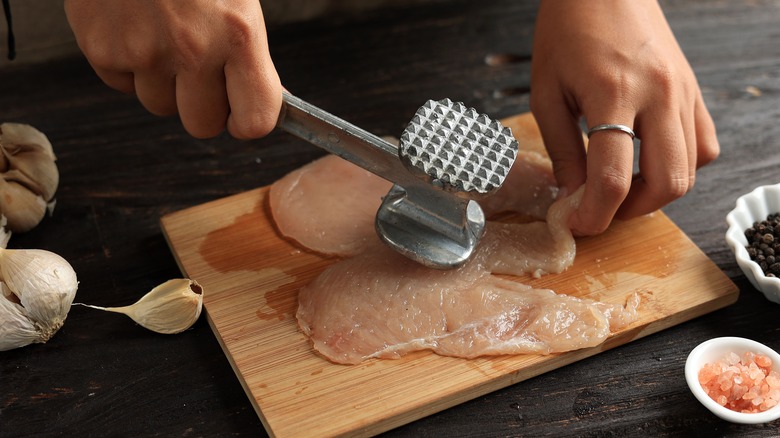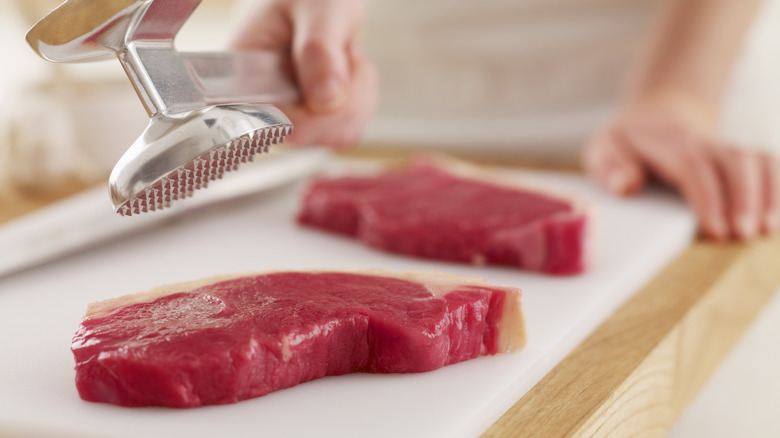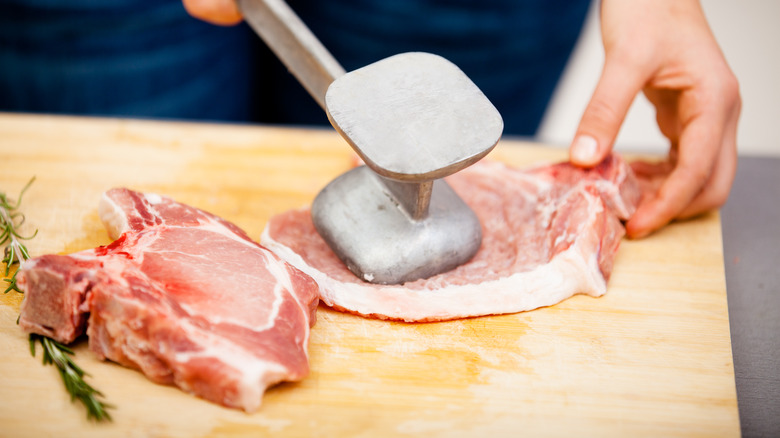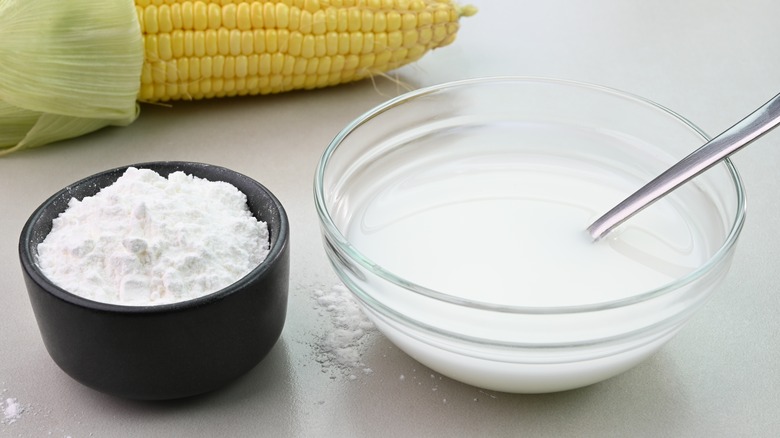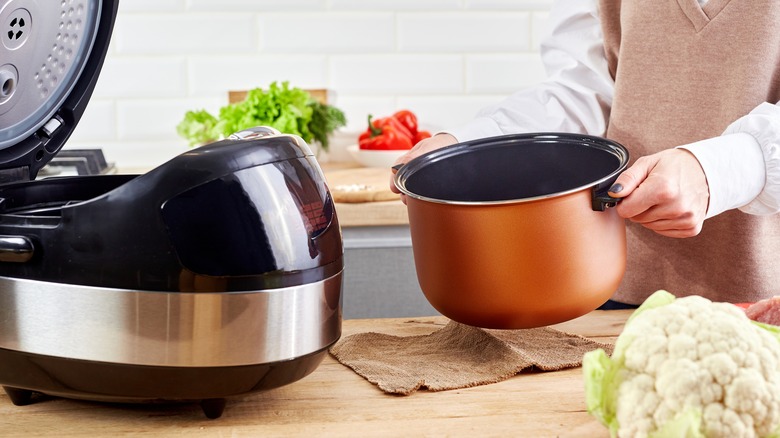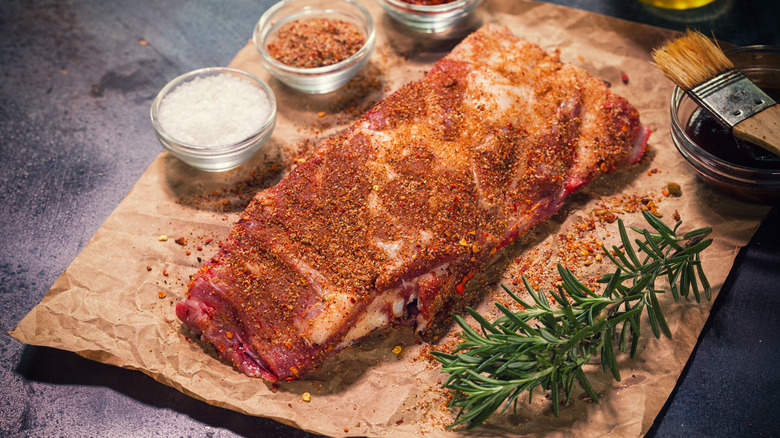8 Mistakes Everyone Makes When Tenderizing Meat, According To A Trusted Expert
Tenderizing meat is one of the best ways to make it taste better. As a chef who's worked with just about every cut of meat under the sun, I've come to appreciate how important it is to have a few different tenderizing methods up my sleeve. At every stage of the cooking process, we should be looking for ways to improve flavor and texture. Tenderizing meat can accomplish both of these things: Not only does it make meat much more succulent, it also allows the flavor of seasonings and marinades to soak into the meat more deeply.
Because there are multiple ways to tenderize, there's potential for some mistakes to be made along the way. As part of my never-ending quest to encourage everyone to cook more, I've taken it upon myself to highlight some common missteps in this area. If you're interested in learning how to tenderize meat and want to sidestep the usual blunders, you're in the right place. Pull out those pork chops, go fetch your meat mallet, and let's dive right in.
1. Mistake: Using the wrong side of the meat mallet
Meat mallets are an essential tool when it comes to tenderizing meat. Most meat mallets have two sides: one with jagged spikes, and one that's smooth and flat. The problem here is that people who don't know any better often use the wrong sides of the meat mallet during the tenderizing process, which can lead to undesirable outcomes and textures.
Although both sides of a meat mallet accomplish the same goal of tenderizing meat, each is designed for a particular purpose. The flat side of the meat mallet is intended to help level out a piece of meat through pounding. If you have a piece of meat that's thicker on one end, you can use the flat side of the meat mallet to tamp it down into a nice, even thickness. This is useful for making dishes like chicken parmesan where you want the cut of meat to be on the thinner side.
The spiked side of the meat mallet is used to break down connective tissue in tougher cuts of meat. Unlike the flat side of the meat mallet, the spiked side is intended to actually penetrate meat. The act of lightly jabbing into the meat and poking little holes into it ends up softening the cut, which makes it more tender. So, before you channel your inner Thor and rain down upon that meat with your mighty mallet, think about what it is that you're actually trying to accomplish and utilize the appropriate side.
2. Mistake: Hitting the meat too hard
It's easy to underestimate just how much damage a meat mallet can do. Although they're typically made from some type of metal, they're also often surprisingly lightweight. While that makes them much easier to handle, it can also translate into getting a little carried away. It's best to wield a meat mallet with some restraint, because if you hit it too hard (especially with the spiked side) it can actually tear right through the meat and turn it into mush.
Using a meat mallet doesn't require much force. Because it's purposefully designed to be top-heavy, there's no need to flex your biceps and pretend you're on a mission to win the Whack-A-Mole grand prize at the local fair. You aren't hammering nails into a hard piece of oak — you're tapping a relatively soft chunk of muscle that came from an animal. Take it easy, give the meat a few taps, and keep your eye on the texture throughout the process so that you don't overdo it. We're trying to tenderize, not pulverize.
3. Mistake: Not using cornstarch
If I had a list of top 10 ingredients that I deem absolutely essential, there's no doubt that cornstarch would earn a spot on it. From thickening up your chili to making the crispiest fried chicken to whipping up some ultra-luscious cheese sauce, cornstarch is one of the most useful ingredients you can have on hand in the kitchen. This is true when it comes to tenderizing — in fact, a lot of people aren't aware of how handy cornstarch can be in this process.
One of my favorite ways to use cornstarch is to tenderize meat for stir fry. After slicing the meat nice and thin, I make a cornstarch slurry by mixing equal parts cornstarch, soy sauce, and light sesame oil. Then I coat the meat in the cornstarch slurry and let it marinate for a bit. Cornstarch actually helps seal in moisture which ends up making meat more tender. Tenderizing meat with cornstarch is also referred to as velveting, a technique commonly used in various forms of Asian cuisine. If you're looking for ways to tenderize strips of meat for stir fry, corn starch is your best friend. Once you give it a try and taste the results, you'll never look back.
4. Mistake: Overlooking citrus juice in the marinade
As a native Floridian, citrus is irrevocably tied to my identity. The fruit stands on the edge of the Everglades from my childhood have slowly disappeared, but I still keep an eye out for them, as if they'll somehow magically materialize back into existence. Such is the delicious power of fresh fruit.
I almost always keep a few oranges, lemons, and limes on hand. Aside from making fresh juice to flavor my drinks, I also like to use them for meat marinades. Not only does the citrus impart a fresh flavor into the meat, the acids in citrus juice also help break down protein to make the meat more tender. This is why carne asada comes out so delicious — the orange juice in the marinade helps tenderize the steak and make it extra succulent. The next time you're marinating meat for tacos, don't forget to add some freshly-squeezed juice into the mix.
5. Mistake: Avoiding slow cooking
When you're hungry, the last thing you want to do is wait a few hours before you can eat. Because slow cooking requires preparing a meal in advance, many people end up avoiding it. What it often boils down to is asking yourself how much time you're willing to spend on preparing meals. But on a day off at home, it's easy to throw some meat in a slow cooker and let it ride all afternoon. The reward of having a fresh source of protein to make multiple meals with is well worth it.
Pot roast is one of my favorite meats to put in a slow cooker. I like seasoning it with salt and pepper and adding a bunch of sliced onions and fresh garlic. After letting it cook on low heat for about eight hours, I let it rest and then shred it into chunks. Then I use the shredded beef on everything from pot roast melts to quesadillas, and it's all thanks to my slow cooker. When the connective tissue and collagen in pot roast is given enough time to simmer, it breaks down and goes from being tough to juicy and unctuous. The bottom line is that taking the time to cook meat slowly is a wonderful way to tenderize it. It requires minimal effort and very little attention, making this a great option for multitaskers.
6. Mistake: Getting the timing wrong
In cooking, timing is half the battle. Sharp skills and good ingredients don't matter much when you accidentally leave some of your best steak cuts on the grill too long and they smolder into inedible bricks. Timing also matters when tenderizing meat, particularly when it comes to marinades.
On the surface, it may seem like a good idea to let your meat marinate in citrus juice for a long time. If the juice tenderizes the meat, then the longer it soaks in, the more tender and delicious the meat will be, right? Wrong. Because the acids break down protein, they can actually end up making the meat straight up mushy if they're left to marinate for too long. There's a big difference between tender and gelatinous. At the same time, when meat is under marinated, it ends up lacking in the flavor department. This usually results from preparing food at the last minute and not having enough time to let it properly marinate.
What we want to do is aim for a balance between these extremes. In general, I find that letting meat marinate for about one day is almost always the perfect amount of time to shoot for. This gives the meat enough time to absorb flavor and improve texture.
7. Mistake: Forgetting to score the meat
Scoring meat is an easy thing to do that comes with a few advantages. Not only does it provide some striking visual appeal, it also helps tenderize the meat. This is particularly effective on leaner, tougher cuts of meat with less marbling, such as flank steak. Scoring the meat severs its long fibers, which ends up making it more tender.
Aside from the textural benefits of scoring meat, scoring also has another major advantage. Slicing into the meat allows marinades and seasoning rubs to penetrate deeper, which makes the meat more flavorful. The biggest thing to remember here is scoring the meat at the right depth. You shouldn't really go any deeper than about ¼ inch in the meat when you're scoring it, and try to keep the lines at least an inch apart. Going deeper can end up making the meat unsightly, and not going deep enough won't effectively improve the texture and flavor. It's also important to make sure you have the right type of knife for scoring meat.
8. Mistake: Not seasoning the meat beforehand
This one may seem obvious, but sometimes people cook meat without seasoning it at all. Or they season meat at the last minute, which means it doesn't really have enough time to fully absorb. Of course, the approach here depends on the type of meat you're cooking. Ground beef shouldn't be seasoned too far in advance if you're making burgers, because the salt will thoroughly break down the protein and give the beef an unpleasantly springy texture. This is why pre-seasoned burgers at grocery stores end up tasting so sausage-like. Don't get me wrong: Springy is good if you're making sausage. But it's not exactly ideal when you're trying to make burgers.
A meat that you do want to season in advance, though, would be whole chicken. When I'm roasting whole chickens in the oven, I rub them down in a seasoning blend a day before they'll be cooked. Similarly, if I'm making ribs, I always try and keep them seasoned for a day before they hit the grill. This not only maximizes flavor, it also tenderizes the meat to make it extra juicy. Moral of the story: Taking the time to plan ahead a bit and adjust your approach depending on the type of meat you're working with goes a long way.
